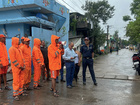Hurricane Melissa left at least dozens dead and caused widespread destruction across Cuba, Haiti and Jamaica, where roofless homes, toppled utility poles and water-logged furniture dominated the landscape Wednesday.
 Full Story
Full Story
When a devastating landslide all but swallowed his Swiss village and toppled his three-generation family-owned hotel in May, Lukas Kalbermatten was overwhelmed by a sense of emptiness before the emotions hit. But he choose not to dwell on them long, and snapped into action to rebuild.
 Full Story
Full Story
The mayor of a southern Haitian coastal town told The Associated Press that 25 people died after a river burst its banks and flooded nearby homes.
Dozens of homes in Petit-Goâve collapsed, and people were still trapped under rubble as of Wednesday morning, Mayor Jean Bertrand Subrème said.
 Full Story
Full Story
An autumn heat wave accompanied by gusty winds raised the wildfire risk for Southern California starting Tuesday, with forecasters warning that grass and brush are still dangerously dry despite recent rains.
 Full Story
Full Story
Floodwaters swept through central Vietnam this week after record-breaking rains, leaving at least 10 people dead and five missing, officials said, as cities, farmland and transport networks were battered by the onslaught.
 Full Story
Full Story
Hurricane Melissa was grinding across Cuba on Wednesday as a Category 2 storm after pummeling Jamaica as one of the strongest Atlantic hurricanes on record, the U.S. National Hurricane Center said.
 Full Story
Full Story
Climate change is ravaging the health of people around the world and policy failures are leading to "millions" of avoidable deaths each year, an international team of experts said Wednesday.
Opportunities for a "just" climate transition were still on the table but remained "largely untapped", according to the Lancet's Countdown, a major annual study tracking the health impacts of climate change.
 Full Story
Full Story
Indian authorities have shut schools and evacuated tens of thousands of people from low-lying coastal areas as the country's eastern seaboard braces for the impact of Cyclone Montha later Tuesday.
 Full Story
Full Story
Heavy rains have caused major flooding in central Vietnam, with rivers swelling and submerging homes, farmland and tourist destinations including the historic cities of Hue and Hoi An.
 Full Story
Full Story
Bill Gates thinks climate change is a serious problem but it won't be the end of civilization. He thinks scientific innovation will curb it, and it's instead time for a "strategic pivot" in the global climate fight: from focusing on limiting rising temperatures to fighting poverty and preventing disease.
A doomsday outlook has led the climate community to focus too much on near-term goals to reduce emissions of carbon dioxide and other greenhouse gases that cause warming, diverting resources from the most effective things that can be done to improve life in a warming world, Gates said. In a memo released Tuesday, Gates said the world's primary goal should instead be to prevent suffering, particularly for those in the toughest conditions in the world's poorest countries.
 Full Story
Full Story



